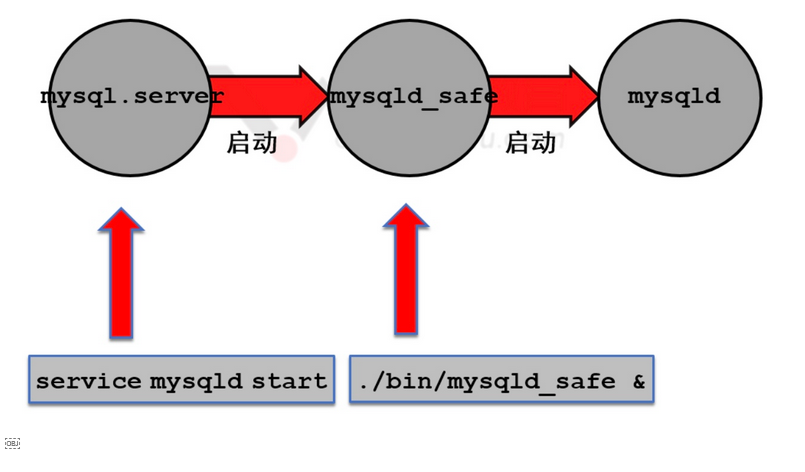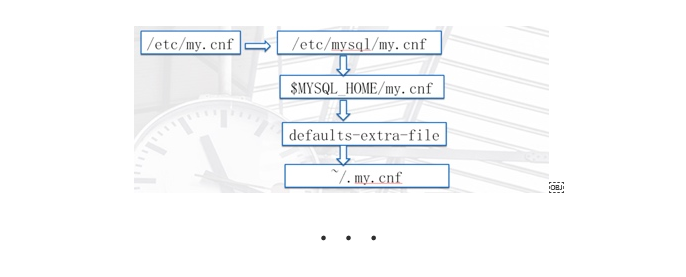1, MySQL 5 6 and MySQL 5 7 difference between
- bostorg was added at cmake
- Use mysqld --initialize instead of MySQL during initialization_ install_ DB, other parameters remain unchanged: - user= --basedir= --datadir=
- --initialize generates a temporary password
- You can also use another parameter -- initialize execute
[root@dba-01 ~]# yum install -y gcc gcc-c++ automake autoconf [root@dba-01 ~]# yum install make cmake bison-devel ncurses-devel libaio-devel [root@dba-01 ~]# wget httpss://dl.bintray.com/boostorg/release/1.65.1/source/boost_1_59_0.tar.gz # Log in to boost Org can also be downloaded [root@dba-01 ~]# tar xf boost_1_59_0.tar.gz -C /usr/local/ [root@dba-01 ~]# cmake . -DCMAKE_INSTALL_PREFIX=/application/mysql-5.7.20 \ -DMYSQL_DATADIR=/application/mysql-5.7.20/data \ -DMYSQL_UNIX_ADDR=/application/mysql-5.7.20/tmp/mysql.sock \ -DDOWNLOAD_BOOST=1 \ -DWITH_BOOST=/usr/local/boost_1_59_0 \ -DDEFAULT_CHARSET=utf8 \ -DDEFAULT_COLLATION=utf8_general_ci \ -DWITH_EXTRA_CHARSETS=all \ -DWITH_INNOBASE_STORAGE_ENGINE=1 \ -DWITH_FEDERATED_STORAGE_ENGINE=1 \ -DWITH_BLACKHOLE_STORAGE_ENGINE=1 \ -DWITHOUT_EXAMPLE_STORAGE_ENGINE=1 \ -DWITH_ZLIB=bundled \ -DWITH_SSL=bundled \ -DENABLED_LOCAL_INFILE=1 \ -DWITH_EMBEDDED_SERVER=1 \ -DENABLE_DOWNLOADS=1 \ -DWITH_DEBUG=0
2, MySQL user permission management
1. Basic MySQL user operations
-
Create user: MySQL > create user bgx;
-
Delete user: delete user drop user
mysql> drop user bgx; Logical operation
MySQL > delete user: to delete the property, find the delete from the table -
Modify user: update
mysql> update mysql.user set host='127.0.0.1' where user='bgx';
Query OK, 1 row affected (0.00 sec)
Rows matched: 1 Changed: 1 Warnings: 0
Note: when updating the password, you must flush privileges, otherwise the changed password will not take effect immediately
2. User definition
- username @ 'host domain'
- Host domain: it can be understood as the white list of MySQL login
- Host domain format:
'10.0.0.51'
'10.0.0.5%'
'10.0.0.%'
'10.0.%.%'
'10.%.%.%'
'%'
'db01'
'10.0.0.51/255.255.255.0'
3. User actual combat management
What you should do after installing MySQL database:
- Set initial password( root@localhost )
[root@dba-01 ~]# mysqladmin -uroot -p password '123'
- Login with password
[root@dba-01 ~]# mysql -uroot -p123
- Clean up useless users
4. What if all users are deleted by mistake?
# Step 1: close the database
[root@dba-01 ~]# /etc/init.d/mysqld stop
# Step 2: start the database
[root@dba-01 ~]# mysqld_safe --skip-grant-tables --skip-networking
# Step 3: use MySQL Library
mysql> user mysql;
# Step 4: create root user
mysql> insert into mysql.user values ('localhost','root',PASSWORD('123'),
('Y',
'Y',
'Y',
'Y',
'Y',
'Y',
'Y',
'Y',
'Y',
'Y',
'Y',
'Y',
'Y',
'Y',
'Y',
'Y',
'Y',
'Y',
'Y',
'Y',
'Y',
'Y',
'Y',
'Y',
'Y',
'Y',
'Y',
'Y',
'Y',
'',
'',
'',
'',0,0,0,0,'mysql_native_password','','N');
5. Forget the root password
# 1. Close the database first
[root@dba-01 ~]# /etc/init.d/mysqld stop
# 2. Start the database
[root@dba-01 ~]# mysqld_safe --skip-grant-tables --skip-networking
# 3. Modify the root password
mysql> update user set password=PASSWORD('oldboy123') where user='root' and host='localhost';
6. User management and authority management
- Create user
mysql> create user oldboy@'10.0.0.%' identified by '123';
- View user
mysql> select user,host from mysql.user;
- delete user
mysql> drop user oldboy@'10.0.0.%';
- Change Password
mysql> set password
mysql> update user set password=PASSWORD('oldboy123') where user='root' and host='localhost';
mysql> grant all privileges on *.* to oldboy@'10.0.0.%' identified by '123';
7. User permission setting
MySQL permission definition:
Target: Library and table
jurisdiction
INSERT,SELECT, UPDATE, DELETE, CREATE, DROP, RELOAD, SHUTDOWN, PROCESS, FILE, REFERENCES, INDEX, ALTER, SHOW DATABASES, SUPER, CREATE TEMPORARY TABLES, LOCK TABLES, EXECUTE, REPLICATION SLAVE, REPLICATION CLIENT, CREATE VIEW, SHOW VIEW, CREATE ROUTINE, ALTER ROUTINE, CREATE USER, EVENT, TRIGGER, CREATE TABLESPACE
ascription
Only one owner can be set at a time. There is no concept of group or other users
grant all privileges on *.* to oldboy@'10.0.0.%' identified by '123';
jurisdiction Action object ascription password
Action object decomposition:
*. * all tables under all databases in the current MySQL instance
wordress.* All tables in wordpress Library in current MySQL instance (single database level)
wordpress.user the user table in the WordPress Library in the current MySQL instance (single table level)
8. Permission settings in the enterprise
#Generally, create user permissions for developers grant select,update,delete,insert on *.* to oldboy@'10.0.0.%' identified by '123';
3, MySQL connection management
MySQL
Common client specific connection options:
- -u: Designated user
- -p: Specify password
- -h: Specify password
- -S: Specify the sock
- -e: Specify sql
- --protocol=name: Specifies the connection method
Connection mode
- socket connection
mysql -uroot -poldboy123 -S/application/mysql/tmp/mysql.sock mysql -uroot -poldboy123
- TCP/IP
mysql -uroot -poldboy123 -h10.0.0.51 -P3306
4, MySQL startup and shutdown process

start-up
/etc/init.d/mysqld start ------> mysqld_safe ------> mysqld
close
/etc/init.d/mysqld stop mysqladmin -uroot -poldboy123 shutdown kill -9 pid ? killall mysqld ? pkill mysqld ?
Problem:
- If the business is busy, the database will not release pid and sock files
- It is claimed that it can achieve the same security as Oracle, but it can not achieve 100%
- Loss of data in case of busy business (remedial measures, high availability)
5, MySQL instance initialization settings
1. Function of initialization configuration file
Scenario: I want to start the instance
Question:
1) I don't know where my program is?
2) I don't know where to find the database after I start up in the future?
3) Where will I put the startup information and error information when I start in the future?
4) Where is the sock file and pid file when I start?
5) How much memory did you give me when I started?
...
N) I have a lot of questions to tell me before I start, emmmmm

- Precompiling: cmake to specify and hard code into the program
- Set the startup initialization configuration on the command line
--skip-grant-tables --skip-networking --datadir=/application/mysql/data --basedir=/application/mysql --defaults-file=/etc/my,cnf --pid-file=/application/mysql/data/db01.pid --socket=/application/mysql/data/mysql.sock --user=mysql --port=3306 --log-error=/application/mysql/data/db01.err
- Initialization configuration file (/ etc/my.cnf)
Configuration file read order:
/etc/my.cnf
/etc/mysql/my.cnf
$MYSQL_HOME/my.cnf (provided that the MYSQL_HOME variable is defined in the environment variable)
Defaults extra file (similar to include)
~/my.cnf

--Defaults file: the default configuration file
If used/ bin/mysqld_ When the safe daemon starts the mysql database, it uses the -- defaults file = < absolute path of the configuration file > parameter. At this time, only the configuration file specified by this parameter will be used.
reflection:
#cmake: socket=/application/mysql/tmp/mysql.sock #Command line: --socket=/tmp/mysql.sock #Profile: /etc/my.cnf in[mysqld]Under the label: socket=/opt/mysql.sock #default parameter: --defaults-file=/tmp/a.txt In the configuration file[mysqld]Under the label: socket=/tmp/test.sock
Priority conclusion:
- command line
- defaults-file
- configuration file
- precompile
2. Use of initialization configuration file
Initialize profile function:
- Affect instance startup (mysqld)
- Affect clients
- mysql
- mysqldump
- mysqladmin
How to configure an initialization profile
- Configure label classification
[Client] all client programs
mysql
mysqldump
...
[server] all server side
mysqld
mysqld_safe
...
6, MySQL multi instance configuration
What is multi instance?
(process + multiple threads + allocated memory structure) * multiple
- Multiple sets of background process + thread + memory structure
- Multiple profiles
- Multiple ports
- Multiple socket files
- Multiple log files
- Multiple servers_ ID file
- Multiple sets of data
actual combat
#Create data directory
[root@db01 ~]# mkdir -p /data/330{7..9}
#create profile
[root@db01 ~]# touch /data/330{7..9}/my.cnf
#Edit 3307 profile
[root@db01 ~]# vim /data/3307/my.cnf
[mysqld]
basedir=/application/mysql
datadir=/data/3307/data
socket=/data/3307/mysql.sock
log_error=/data/3307/mysql.log
log-bin=/data/3307/mysql-bin
server_id=7
port=3307
[client]
socket=/data/3307/mysql.sock
#Edit 3308 profile
[root@db01 ~]# vim /data/3308/my.cnf
[mysqld]
basedir=/application/mysql
datadir=/data/3308/data
socket=/data/3308/mysql.sock
log_error=/data/3308/mysql.log
log-bin=/data/3308/mysql-bin
server_id=8
port=3308
[client]
socket=/data/3308/mysql.sock
#Edit 3309 profile
[root@db01 ~]# vim /data/3309/my.cnf
[mysqld]
basedir=/application/mysql
datadir=/data/3309/data
socket=/data/3309/mysql.sock
log_error=/data/3309/mysql.log
log-bin=/data/3309/mysql-bin
server_id=9
port=3309
[client]
socket=/data/3309/mysql.sock
#Initialize 3307 data
[root@db01 ~]#/application/mysql/scripts//mysql_install_db --user=mysql --defaults-file=/data/3307/my.cnf --basedir=/application/mysql --datadir=/data/3307/data
#Initialize 3308 data
[root@db01 ~]#/application/mysql/scripts//mysql_install_db --user=mysql --defaults-file=/data/3308/my.cnf --basedir=/application/mysql --datadir=/data/3308/data
#Initialize 3309 data
[root@db01 ~]#/application/mysql/scripts/mysql_install_db \
--user=mysql \
--defaults-file=/data/3309/my.cnf \
--basedir=/application/mysql --datadir=/data/3309/data
#Modify directory permissions
[root@db01]# chown -R mysql.mysql /data/330*
#Start multiple instances
[root@db01]# mysqld_safe --defaults-file=/data/3307/my.cnf &
[root@db01]# mysqld_safe --defaults-file=/data/3308/my.cnf &
[root@db01]# mysqld_safe --defaults-file=/data/3309/my.cnf &
#View server_id
[root@db01]# mysql -S /data/3307/mysql.sock -e "show variables like 'server_id'"
[root@db01]# mysql -S /data/3308/mysql.sock -e "show variables like 'server_id'"
[root@db01]# mysql -S /data/3309/mysql.sock -e "show variables like 'server_id'"